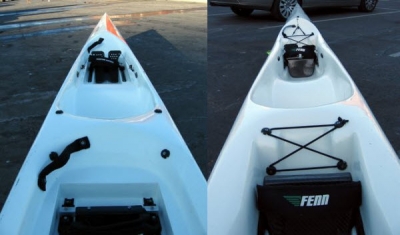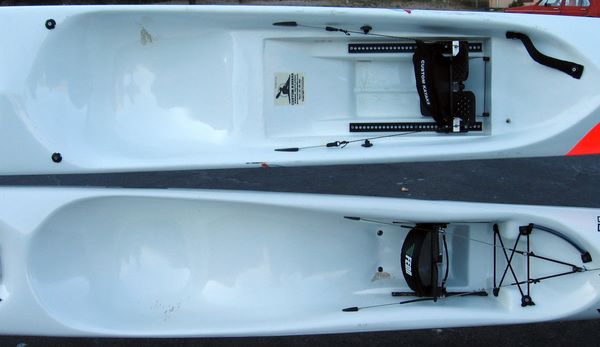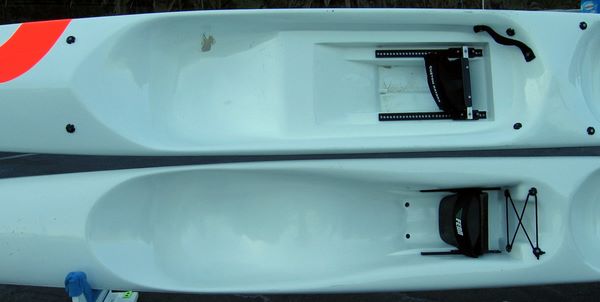Doubles Comparison: Elite v Apex
 Doubles Comparison
Credits: www.surfski.info
Doubles Comparison
Credits: www.surfski.info
[Three weeks ago, Dale Lippstreu and I did back-to-back Millers Runs in two different double skis: the Fenn Mako Elite Double and the Custom Kayaks Apex. Dale was the driver in both cases.]
Build Quality
Both skis are finished well. If anything the Apex seems to have the edge in terms of attention to detail. The Apex used was a lightweight hybrid lay-up model and the Elite was a standard glass model. I am not sure how much extra the hybrid lay-up costs but if I were buying an Apex and it was not too expensive I would go with this option.
Sea Conditions
It needs to be stated upfront that the skis were compared in big sea and wind conditions [Editor: "big" means 25kts and 3-6ft waves] which if anything became bigger on the second run when the Apex was paddled. The criteria by which the skis are compared therefore relate largely to these conditions and factors such as stability and the ability to keep out and shed water have been given more importance than they ordinarily would in a more rounded appraisal of the skis.
Dismal Cockpit Drainage
The length of double skis makes them inherently wet in choppy seas and downwind conditions. Keeping water out of the foot wells, minimizing the volume of foot wells and having effective balers are therefore of greatly increased importance in a double. The Elite is a lot better on the first 2 aspects as it has higher cockpit sides (5-6 cm higher) and a narrower interior. The Apex footplate adjustment tracks are mounted flat (as opposed to vertically) on the cockpit sides which makes for a big increase in interior width and volume and as a result the Apex cockpit holds about the same amount of water despite the fact that it has much lower sides. I can only describe the balers on both skis as dismal. It really surprises me that manufacturers still use old style balers when Epic and Red7 have shown the way with vastly improved balers which are just as easy to fabricate.
Front Seats
Rear Seats
Stability
I have paddled an Elite for about a month and can only say that the stability is remarkable. My first impression of the Apex was to note the greater width at the catch and the seating position which seemed higher and more comfortable than the Elite. In the calmer protected water of Rumbly Bay the stability of the Apex felt similar but the moment we encountered the ocean swell I started to find it quite tippy. My discomfort was heightened by the fact that I did not feel securely contained by the seating bucket which felt too broad for me and too low. I weigh 94 kg so I can only guess that slimmer paddlers would feel even less "contained" and secure.
Video
[Editor: The video bears out what Dale said about his discomfort - you can see how tentative he is in the Apex. Compare that with the video we made when we were paddling the Elite, where he's taking strong, regular, confident strokes.
Swimming
Half way between the lighthouse and Fish Hoek we took off down a massive face, smacked into the wave in front and flew out of the boat. The video gives a unique view of the remounting operation! The first time I got in bum first, lost my balance and fell in again backwards, tipping Dale off as I did so. On the second attempt, I remounted straddle-style. Lessons learnt: The driver should get in first - the paddler in the back can help steady the ski. The second paddler should get in straddle-style.
Given that it took us two goes to get it right - I can report that the Apex is an easy ski to remount.]
Speed
It is very difficult for me to make a really meaningful comparison of the performance of the skis because, to be honest, I did not feel sufficiently confident in the Apex to give it a full go. Whatever I say should therefore be regarded in this context.
I mentioned in my review of the Elite that it has a remarkable ability to hold its speed once going and this enables one to link runs together to a degree that I had not experienced before. I found the Apex to be quick onto the runs but not as easily kept there. I suspect that this is due to greater forward volume which would make it harder to push through runs as you overtake them. We therefore stalled more off the back of runs flooding the ski each time in the process. The big buckets and low sides became an issue whenever this occurred and sometimes hooking my feet into the foot strap was all the kept me from being washed out of the ski.
Steering
I found the steering on the Apex was less direct and authoritive than on the Elite. I found that it was necessary to hold the rudder jammed full right paddling cross wind out to Bakoven Rock to start the run. In the Elite I must have done some rightward correction but not to the extent that I noticed doing it. The Elite also seemed to steer better on the runs but it is only fair to point out that in the Elite we were going for it whereas we were a lot more tentative on the Apex and, as any downwind paddler knows, forward momentum is the key to control.
Measurements
|
Measurement |
Position |
Fenn |
Apex |
|
Bucket Depth |
Front |
250mm |
195mm |
|
|
Rear |
230mm |
210mm |
|
Width at pedals |
Front |
380mm |
425mm |
|
|
Rear |
460mm |
505mm |
|
Bucket Width (outside) |
Front |
450mm |
480mm |
|
|
Rear |
430mm |
500mm |
|
Bucket width (inside) |
Front |
395mm |
425mm |
|
|
Rear |
390mm |
435mm |
Conclusions
My overall conclusions: The Elite is a more stable and drier ski in big conditions. I would have to paddle both skis again in more "regular" conditions in order to offer a fully rounded opinion as to their general characteristics and performance across all conditions.





